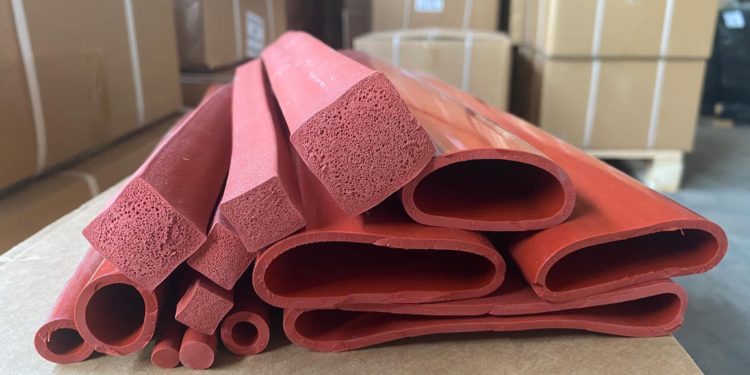Silicone sponge strips are a versatile and innovative solution, seamlessly merging flexibility with durability. Made from a unique blend of silicone rubber and air-filled cells, these strips provide not only insulation but also exceptional cushioning properties. This dual functionality makes them ideal for applications ranging from construction to automotive sectors, where they help to seal spaces against moisture while maintaining structural integrity. Their lightweight nature ensures that they don’t add unnecessary bulk, making them an efficient choice for various projects.
One of the standout features of silicone sponge strips is their resilience in extreme conditions. They can withstand high temperatures without losing their shape or performance, making them perfect for environments that experience significant thermal fluctuations. Additionally, these strips are often resistant to chemicals and UV rays, further extending their lifespan and reliability in outdoor applications. As industries move towards more sustainable practices, the longevity and lower environmental impact of silicone sponge materials present compelling advantages over traditional foam options—showing that innovation in materials science can indeed lead to greener solutions.
Key Characteristics of Silicone Sponge Strips
Silicone sponge strips are remarkable for their unique combination of flexibility and durability, setting them apart from other materials commonly used in sealing applications. One of the standout characteristics is their excellent resistance to extreme temperatures, allowing them to maintain functionality in both high-heat and low-temperature environments. This thermal stability makes them ideal for industries ranging from automotive to aerospace, where components face varying temperature extremes. Additionally, silicone rubber’s natural resilience enables these strips to withstand repeated compressions without compromising their sealing capabilities.
Another vital feature of silicone sponge strips is their superior compression set resistance, which ensures that they keep their shape and effectiveness over time. Unlike traditional foam or rubber options, these strips do not easily deform under pressure; instead, they return to their original form after being compressed. This attribute extends the lifespan of seals and gaskets in applications like HVAC systems or kitchen appliances where consistent performance is crucial. Furthermore, they provide an effective barrier against dust, moisture, and air infiltration—making them indispensable for creating energy-efficient structures while enhancing overall product integrity.
Moreover, the versatility of silicone sponge comes into play with its adaptability across various applications. These strips can be custom-cut and shaped with ease to meet specific design requirements—a trait particularly appealing for manufacturers seeking tailored solutions for complex assemblies. Their ability to bond well with different substrates allows seamless integration into diverse environments without sacrificing performance quality. In summary, the key characteristics of silicone sponge strips not only enhance operational efficiency but also drive innovation in product design across multiple industries.
Advantages Over Traditional Materials
Silicone sponge strips offer a remarkable advantage over traditional materials due to their exceptional durability and flexibility. Unlike wood or fiberglass, which can warp or crack under stress or varying temperatures, siliconemaintains its integrity even in extreme conditions. This resilience makes it ideal for applications ranging from automotive gaskets to kitchen seals, where long-lasting performance is essential. Additionally, the lightweight nature of silicone allows for easier handling and installation compared to heavier traditional materials.
Moreover, silicone sponge strips demonstrate superior thermal stability and insulation properties. While conventional materials may fail to provide adequate temperature regulation, silicone effectively withstands a wide range of temperatures without losing its shape or function. Its ability to compress and recover also ensures a tight seal that reduces energy loss—a critical factor in both commercial and residential settings striving for efficiency. In essence, opting for silicone not only enhances product longevity but also contributes to sustainability by minimizing the need for frequent replacements and repairs.
Maintenance Tips for Longevity
To ensure the longevity of silicone sponge strips, regular maintenance is key. Start by cleaning them periodically with mild soap and warm water to remove any dust or debris. Avoid harsh chemicals that could deteriorate the material; instead, opt for natural cleaners that are gentle yet effective. After washing, it’s essential to allow the strips to air dry completely before reuse—trapped moisture can lead to mold growth or a breakdown of the silicone over time.
Another vital aspect of maintenance is proper storage. Store your silicone sponge strips in a cool, dry place away from direct sunlight and extreme temperatures that can compromise their integrity. Consider using a dedicated container or bag to prevent unnecessary bending or stretching when they’re not in use. By taking these simple steps, you not only prolong the life of your silicone products but also ensure consistent performance for your projects—be it in crafting, automotive applications, or household uses—allowing them to serve you well for years to come.
Conclusion: The Versatility of Silicone Sponge Strips
In conclusion, the versatility of silicone sponge strips is truly remarkable, making them a staple in various industries and day-to-day applications. Their unique properties—such as flexibility, durability, and resistance to extreme temperatures—allow them to excel in roles that demand both performance and reliability. From providing essential cushioning in automotive interiors to sealing edges in construction projects, these strips adapt effortlessly to meet specific needs.
Beyond traditional uses, the rise of eco-conscious consumerism has spotlighted silicone sponge strips as sustainable alternatives to plastic foams or rubber products. Their longevity means fewer replacements over time, directly contributing to waste reduction. Furthermore, with advancements in design and manufacturing techniques, we are witnessing innovative applications emerging across tech devices and home improvements—showcasing how these humble strips can elevate functionality and aesthetics alike. Embracing silicone sponge strips isn’t just a practical choice; it represents a commitment to pushing boundaries toward smarter living solutions.











































































